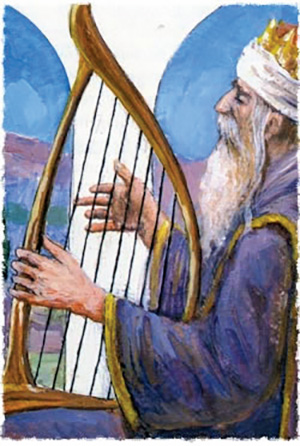
Parshat Chayei Sarah
This week’s haftarah, the opening chapter of Sefer Melachim, compares and contrasts the final days of David HaMelech with those of Avraham Avinu, of which we read in the parsha itself. The very first words of the haftarah echo the first words of the 25th perek of Bereishit, i.e., “V’Hamelech David zaken-ba bayamim”—“V’Avraham zaken ba bayamim; both tzadikim were getting on in years. And although Avraham was past his 137th year while David had not yet reached the age of 70, Avraham is depicted as being fully functioning and capable of providing for the future of his family. On the other hand, David HaMelech is described as being weak, unable to keep himself warm and unaware of the fact that his oldest surviving son was planning a coup to undermine his own plans for the future of his kingdom.
But is that the whole picture?
When we turn to the Book of Divrei HaYamim we find a very different story. There, from the 23rd through the 29th chapters, we read of the final days of King David. But he is not the weakened, feeble, elderly regent described in the Book of Melachim. Quite the opposite! Here we read of the flurry of activity that David HaMelech undertook in his last days, when he was “zaken v’savah yamim,” “old and fulfilled of days.” He gathers all of the leviyim, counts them and divides them into 24 divisions for future service in the Beit Hamikdash. He also takes a census of the kohanim and divides them into 24 divisions for their service in the Beit Hamikdash. He also organizes the levites into a singing division and gatekeepers as well as other assignments, in order to ensure the proper functioning of the Temple service. And if this were not enough, David also appoints officers of the realm, tribal leaders and royal officers.
The text also reveals that in his final days, David gathers all the leaders of Israel and publicly appoints Shlomo as his successor to the throne. He charges his young son to build the holy Temple and follow Hashem’s commands. He gives over the blueprint for the Beit Mikdash that he had prepared and the treasures he had gathered over the years for the Temple treasury. He calls to the people for voluntary donations and celebrates with them upon seeing the generous contributions that poured in. Finally, we read the long address that David shares with the nation, part of which has become a daily tefilla for us today.
So… will the real David please stand up!! Weak and failing or vibrant and energetic?
In truth, he may well have been both. The aged regent may have found it difficult to lead a nation in his final days. But when it was time to hand the torch down to the next generation, David girded himself in strength and prepared his son and his people for the challenges they were to meet.
What truly moves a person to action? For David HaMelech it was the opportunity to fulfill Hashem’s will and prepare the nation for service in the Beit Hamikdash. He would not miss the opportunity to help bring to fruition that dream of his life. What dreams do we have that will move us to action even in our last days?
Hopefully, dreams like David HaMelech had.
By Rabbi Neil N. Winkler
Rabbi Neil Winkler is the rabbi emeritus of the Young Israel of Fort Lee and now lives in Israel.









